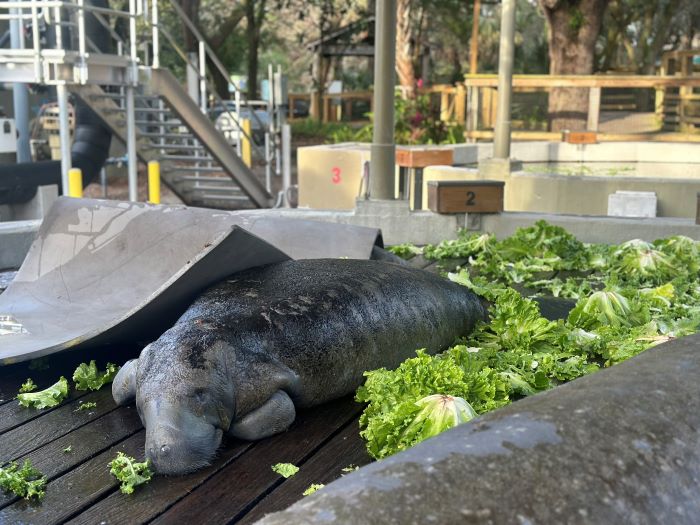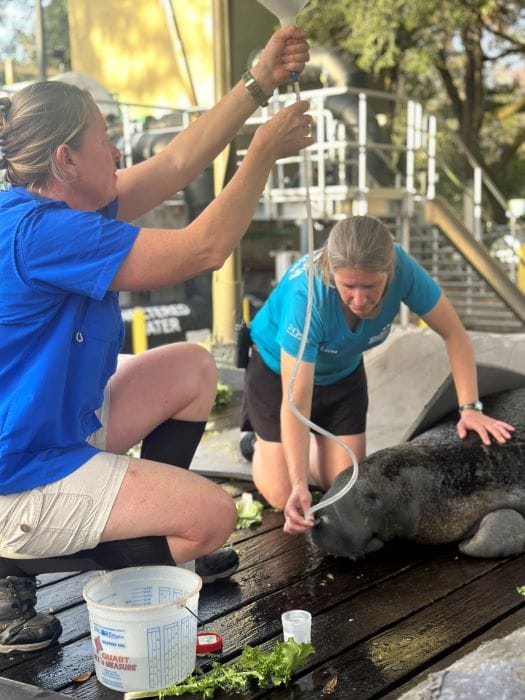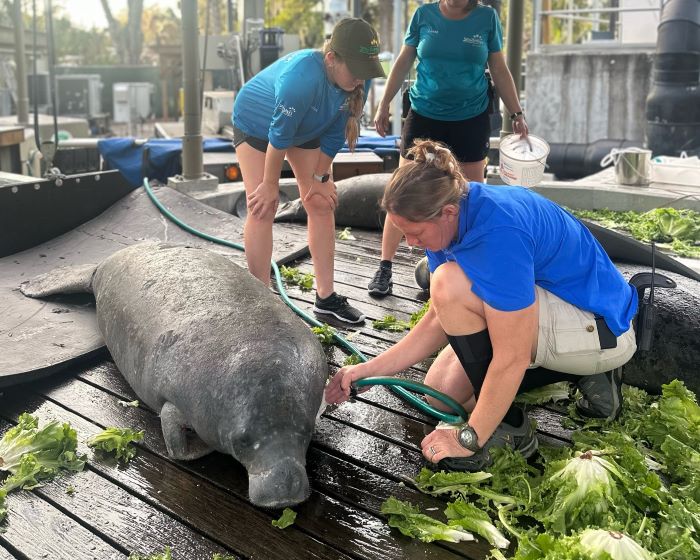ZooTampa’s Manatee Hat Trick: Rescue, Rehab, Release
Manatees are among Tampa Bay’s natural gifts. Aquatic mammals and herbivores, manatees spend spring days swaying through our area’s warming waters. Endangered species, manatees don’t thrive in water colder than 68 degrees.
With no natural predators, cold temperatures and boat propellors are manatees’ greatest threats. Through more than 20 years of life-saving work, ZooTampa’s world-renowned Manatee Critical Care Center—a non-profit, acute care facility—has treated over 400 manatees. Manatee rescue, rehabilitation and release drive the Center’s work.
A Closer Look: the Manatee Critical Care Center at ZooTampa
Jamie Vaccaro, ZooTampa’s Associate Curator of Florida and Manatee, invited me into the Manatee Critical Care Center and spoke with me about our waters’ delicate giants. Cold stress, Jamie explained, was the cause for the zoo’s most recent manatee arrivals.

Resembling human frost bite, cold stress can cause white lesions on manatee’s bodies. Mainly muscular and blubber free, manatees are cold intolerant—hence migrations toward the bay area’s natural springs, which maintain year-round temperatures of 72 degrees.
Unable to compensate for heat loss, manatees decrease activity to preserve energy. Resulting lethargy and secondary infections, like pneumonia and hyperthermia, set in.
On Jan. 25, 2024, a trio of manatees, deemed the Hat Trick, was rescued. “We like naming our rescues after either the cause or location of rescue,” Vaccaro explains. “Given their cold stress, we named them Zamboni, Puck and Icing.”
Zamboni and Puck, about a year old, were rescued from St. Pete’s Placido Bayou where they were stranded in a ditch. Icing, an estimated 2-year-old with an intake weight of 550 pounds, was rescued from Bradenton’s Ware Creek.
Manatees’ ages are approximated based on their length.
“When rescues arrive with cold stress, we get them into warm water as soon as possible so that we can raise their internal body temperature,” Vaccaro says. Manatees undergo diagnostic labs and bloodwork, enabling the critical care center team to provide each patient with individualized fluid therapy. Medical pool floors rise from the water—limiting manatees’ motion during events like tube feeding.

Once hand feeding is unnecessary, manatee care is as hands-off as possible so that manatees learn life skills needed after release. “Two years is typically the longest stay for orphaned manatee calves, and they learn more manatee behaviors from manatee groups found at release sites,” Vaccaro says.
Releases are well-orchestrated undertakings, entailing the Florida Fish and Wildlife Commission and Manatee Rehabilitation Partnership. “Through our partnership with the Clearwater Marine Aquarium, manatees are tagged, similar to household pets’ microchips, and tags both gather and share data detailing individual manatee’s progress.”
Vaccaro says she feels privileged for her daily part in changing animals’ lives.
Summer 2024 brings expansion to the Manatee Critical Care Center with the addition of acute care and nursery pools to serve dire cases. Projected to open in January 2026, ZooTampa’s new Manatee Rescue promises to bring guests as close as possible to manatees’ lives while promoting education through transparency.
Guests’ proximity to manatees and the critical care team will allow them to see, in real time, the Center’s lifesaving efforts. “Manatees are in our backyards, and I want to harness the power of educational conversations with ZooTampa guests about the why and how of what we do,” Vaccaro says. She and her teammates are intent on teaching humans positive behaviors for coexisting with manatees.
Adopt a Manatee: https://zootampa.org/animals/west-indian-manatee/
Photos by Tara Payor | Originally published in the March 2024 issue of Tampa Bay Parenting Magazine


